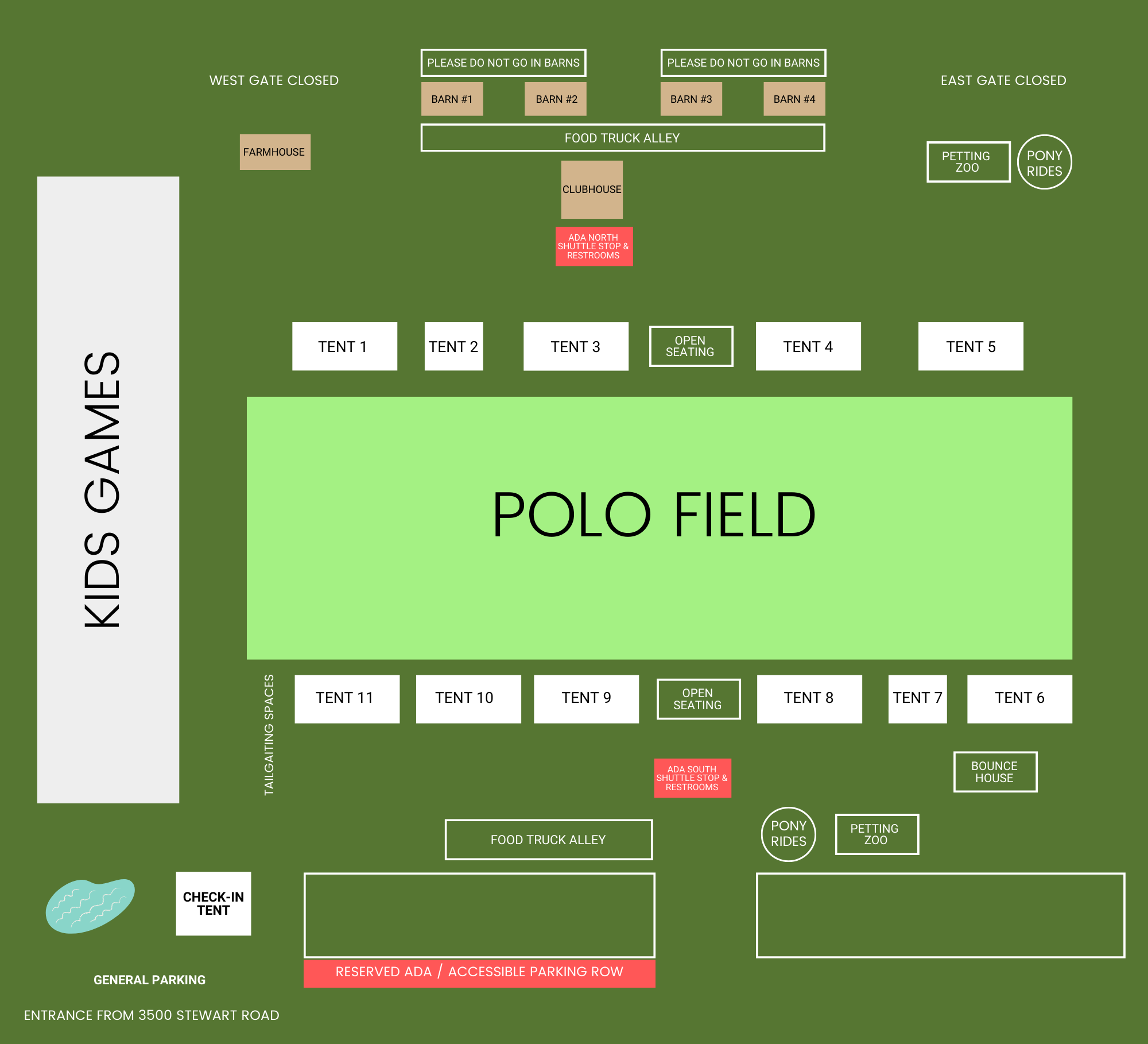About Our Event
Event Map

Schedule of Events
11:00 AM - Gates Open
12:00 PM - Polo Match
HALFTIME - Divot Stomp & Best Hat Contest
What is Polo and How Does it Work?
Polo is a ball game played on horseback on a field and is one of the world's oldest known team sports. The game is played by two opposing teams with the objective of scoring using a long-handled wooden mallet to hit a small hard ball through the opposing team's goal. Each team has four mounted riders, and the game usually lasts one to two hours, divided into periods called chukkas or "chukkers".
There are six periods, called “chukkers,” in a polo game, each lasting 7 minutes. At the end of the 6 1/2 minutes, a bell sounds to let the players know 30 seconds remain. At 7 minutes, a horn sounds to end the period.
In the event of a tie at the end of the final chukker, there is a 5-minute intermission to allow the players to catch their breath and change to a fresh mount before beginning a chukker in which the first team to score wins the match.
What Do the Players Numbers Mean?
Number 1 is a forward, and attacking offensive player similar to a wing in hockey or a forward in soccer. Number 1 is also expected to “ride-off” the opposing defensive player allowing a trailing teammate the opportunity to score, similar to a blocking back in football.
Number 2 is also an offensive player, expected to be able to turn quickly and follow the lead of the Number 1 in order to be in position to pick up a pass or pick up a missed or blocked shot. His or her defensive responsibility is the opposing Number 3.
Number 3 is the field general. He or she attacks the opposing offense and turns the ball upfield, usually with a pass ahead to Number 1 or Number 2. The Number 3 must be able to hit long with accuracy. The Number 3 also aids in defense, taking the opposing Number 2 or offering defensive support to his or her Number 4.
Number 4 (also called the “Back”) defends the goal and sends the ball back towards the opponents’ goal. These roles are flexible, however, and in the rapid course of a game players may swap positions until they have a chance to return to their place on the field.
Polo Terminology
Boards: Short boards along the sidelines of the field to help keep the ball in play.
Bump: When a player directs his pony into the side of an opponent’s pony to move an opposing player off the line of the ball.
Goal: Anytime the ball crosses the line between the goal posts, regardless of who (including ponies) knocks it through.
Hook: Defending an opponent’s swing by blocking it with your own mallet.
Knock in: After the ball crosses the back line, the defending team knocks the ball back into play from their own back line.
Line of the ball: The imaginary line produced by the ball when it is hit or deflected. This creates an invisible right of way that players must adhere to for safety.
Mallet head: The part of the mallet used to strike the ball. The wide face of the head is used to strike the ball.
Nearside: The left hand side of the polo pony.
Offside: The right hand side of the polo pony.
Penalty: A free hit is awarded to the fouled team, from a set distance determined by the severity of the foul committed. Most occur because players improperly cross the line of the ball. All penalties are called to maintain the safety of both the horses and the riders.
Ride off: Two riders may make contact and attempt to push each other off the line of the ball to prevent an opponent from striking the ball.
Stick: The polo mallet.
Swing: Hitting the ball using one of the four basic shots: forehand, backhand, neck and tail.
Tack: All the equipment used on a polo pony.
Throw in: Play is started by throwing the ball down the center of a line-up of players and horses.
Attractions
Food Trucks
Pony Rides
Kids Games
Bounce House
Petting Zoo